

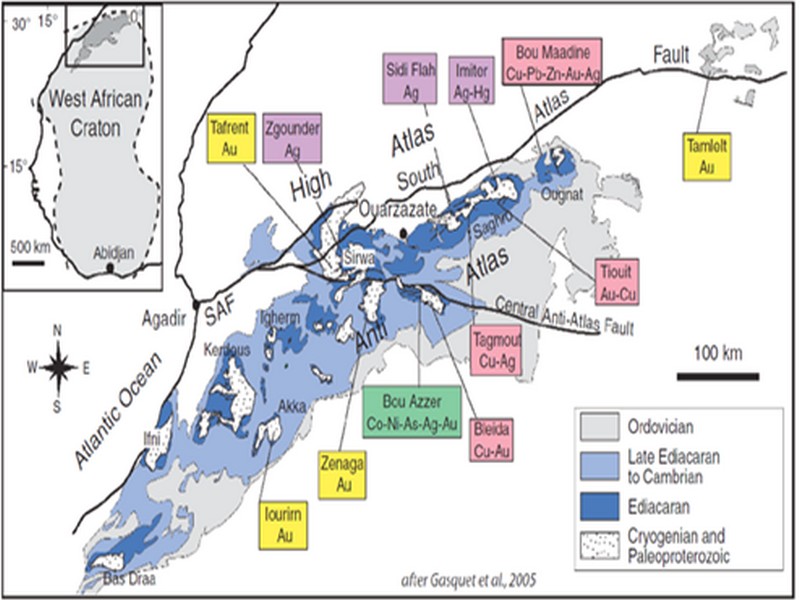
ORE DEPOSITS IN THE ANTI-ATLAS AND SUB-ATLAS REGIONS
The Anti-Atlas geological province is the host of a variety of ore deposits, ranging from Paléoprotérozoïque to Ordovician in age. These deposits are mainly Cu-Au porphyry types, precious metal epithermal (Au, Ag) or polymetallic VMS base metals (Cu, Pb, Zn, Au, and Ag), while the sub- Atlas region presents an important occurrence of manganese. Figure 8 shows the location of the most important deposits in the Anti-Atlas region.
Located in eastern Anti-Atlas, the world class Imiter Ag-Hg mine (8.5 Mt at 700g/t Ag), is among the most important deposits in Morocco. It is considered to be of epithermal origin. The silver mineralisation happened during regional extension (+/- transpession?) tectonic regime event around 550 and is hosted in a series of volcanic felsic rocks Ma (Tuduri et al, 2006). Briefly, a three-stage model has been proposed to explain the deposit: a first episode characterized by the development of quartz, pink dolomite, and Ag-rich minerals veins formed during a dextral transpressive event, followed by a barren stage associated with a normal left-lateral motion that re-opened previous structures, and a final alteration stage (i.e. supergene enrichment) that contributed to local enrichment in Ag deposit (Tuduri et al, 2006).
Regarding copper, Bleida was the most important Cu deposit of northern Africa until late 90’s. Located on the northern edge of the West African Craton, the Bleida orebodies are located on an inactive continental margin along with preserved ophiolites of Upper Proterozoic age. The copper deposits (chalcopyrite, bornite, pyrite) are stratiform distal massive sulfide bodies whose position is controlled by both the sedimentation of shales and an acid volcanism, which follows a more important basic volcanism. Pan-African deformation (650-600 Ma) has determined the current geometry of the cupriferous lenses although it has not remobilized the sulfides out of their original carrier beds (Leblanc and Billaud, 2006). West of the main Moroccan Bleida copper deposit, gold mineralization has also been discovered (West Bleida, ca. 3 tonnes metal Au). It is hosted by metamorphosed and deformed mafic to intermediate volcanic rocks that are part of the Neoproterozoic tholeiitic volcano-sedimentary series forming the stratigraphically upper part of the Bou Azzer ophiolite sequence. Gold mineralization primarily occurs
as deformed gold-bearing quartz veins and disseminations in Cu-rich chert zones (chalcopyrite– malachite), Fe-rich lithofacies and breccia zones. Gold is accompanied by small amounts of copper sulphides (<1% modal chalcopyrite).
Another important occurrence (not displayed in the map, Fig. 8) is the Imini Manganese deposit, the most important Mn deposit of Morocco, located in the western margin of the Ouarzazate foreland basin (Sub-Atlas). The manganese ore is made of pyrolusite (MnO2), and is hosted in different horizons of dolomites from the lower Cretaceous, and another accessory layer. This layers thickness can reach up to 1 meter. The deposit scale is 25 km per 100-400 m width, and sits above slates and crystalline rocks. Dolomitic sandstone and/or conglomerate are present between each mineralized horizon. Isabel von Steinaecker; source: http://www.geo.tu-freiberg.de/oberseminar/os03_04/Isabel_Steinaecker.pdf).
Figure 8: The Anti-Atlas belt at the northern limit of the West African Craton. Redrawn after Dallmeyer and Lecorché (1991) and a geological sketch map of the Anti-Atlas belt in southern Morocco and location of main ore deposits. SAF: South Atlas Fault. Gasquet and al. (2005)
Source web par unige.ch
Les articles en relation
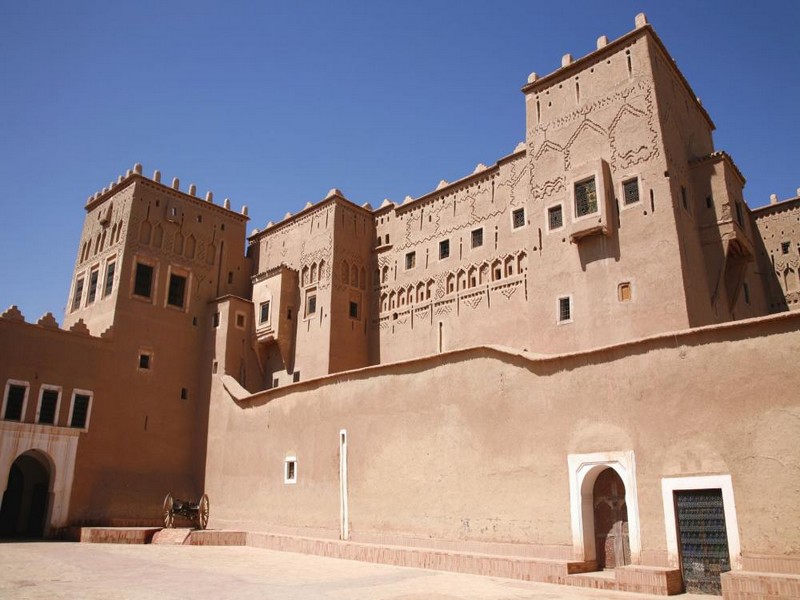
Kasbahs et ksour du sud-est marocain : TAOURIRT (Géoparc jbel bani)
Kasbahs et ksour du sud-est marocain : TAOURIRT (Géoparc jbel bani) Conformément à la tradition orale, la kasbah de Taourirt aurait été édifiée au 17ème siècle. Son
Savoir plus...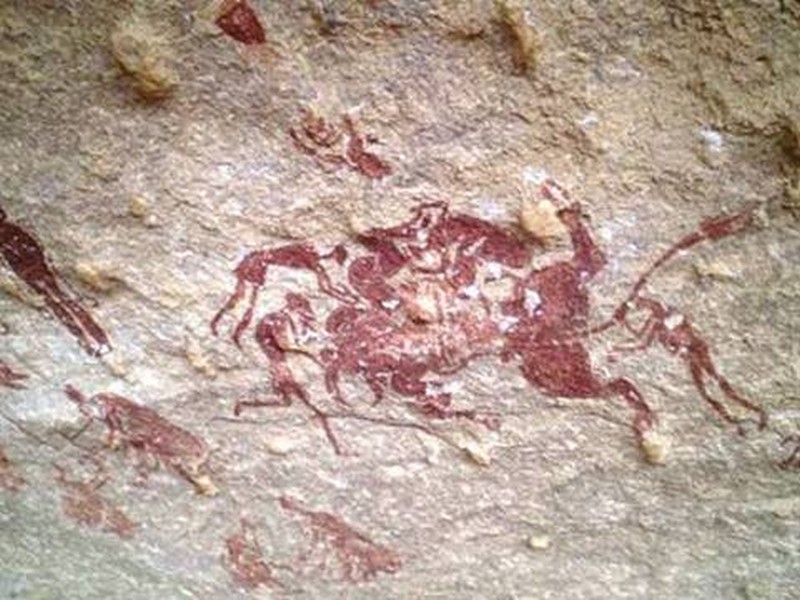
Appel à la protection des gravures rupestres de Nâama
Appel à la protection des gravures rupestres de Nâama Découverte en 1847 par une expédition française, la station de Tiout, dans le Sud de la wilaya de Naâma, date de plus de 8 000 ans avant J.
Savoir plus...
Le géologue, entre nomadisme et sédentarité » par Hervé LEYRIT
Le géologue est-il un aventurier, un nomade, un vagabond? Ou bien est-il un jeune cadre dynamique qui intègre la mondialisation dans sa carrière? Dans sa vie professionnelle, l'expatriation sera-t-elle choisie o
Savoir plus...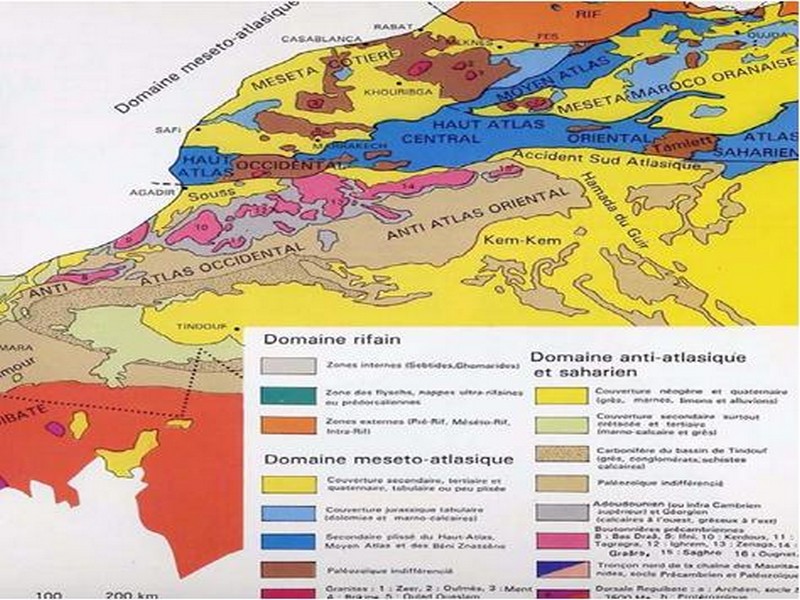
Context geoghraphique , geologique et hydrogeologique
Context geoghraphique , geologique et hydrogeologique Professeur Bakkali Saad et Professeur Bouyalaoui Jaâfar Universidad de Guadalajara Guadalajara, México La zone étudiée appartient géographi
Savoir plus...
Tata - Anti Atlas - Couleurs de la Porte du Sud (Géoparc Jbel Bani)
Tata - Anti Atlas - Couleurs de la Porte du Sud (Géoparc Jbel Bani) Que l'on s'y rende à partir de Marrakech, Agadir, Ouarzazate, on sera toujours surpris, quelque soit la saison, de la diversité des coul
Savoir plus...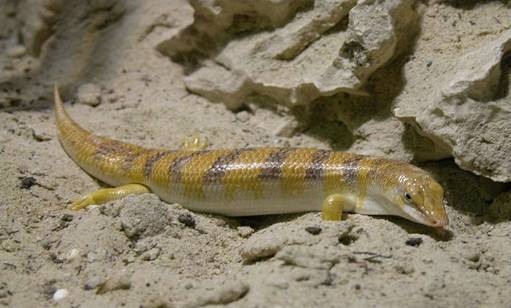
Scincus scincus, le poisson du Désert
Egalement connu sous le nom de poisson des sables, poisson du désert ou de lézard des sables, le Scincus scincus (scinque) est un reptile qui mesure jusqu’à 25 cm de longueur. Parfaitement adapté au cli
Savoir plus...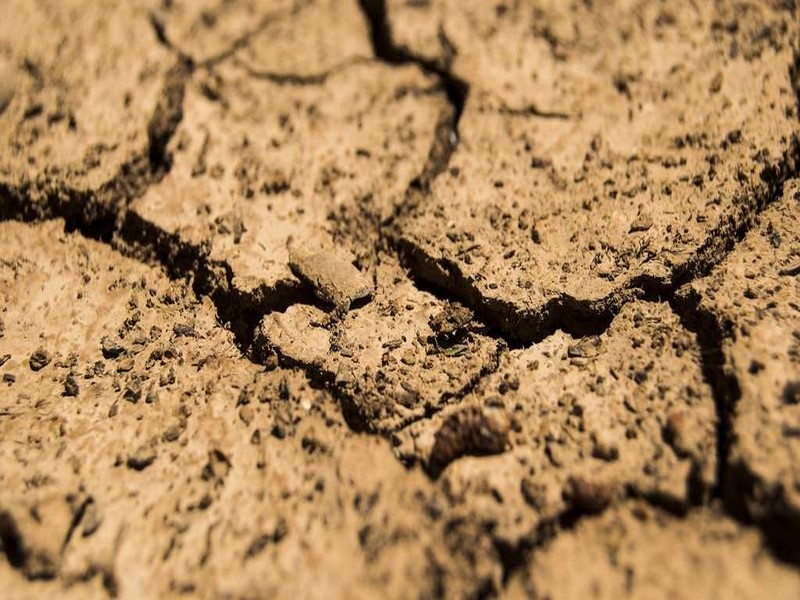
Stress hydrique
Stress hydrique Le terme de stress hydrique est apparu relativement récemment pour rendre compte d'une situation de plus en plus fréquente. Ainsi, il est employé pour désigner ces périodes duran
Savoir plus...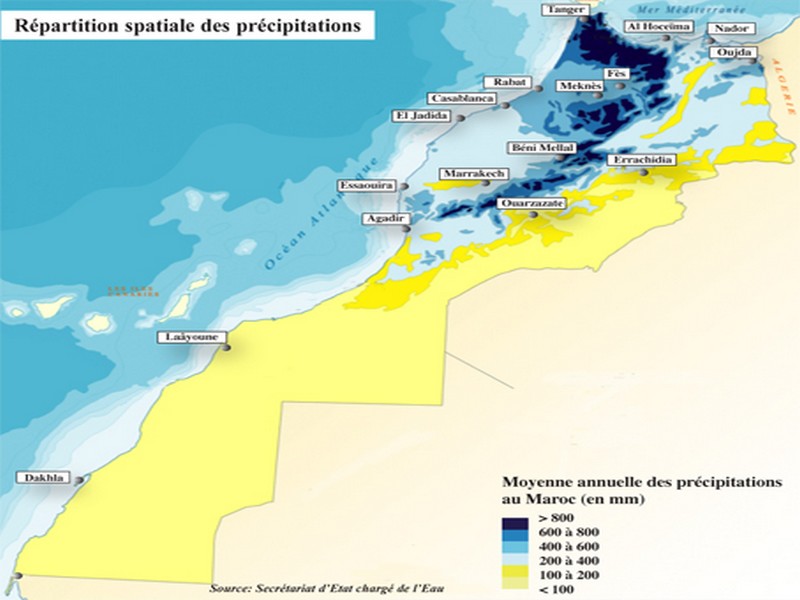
Retard des pluies: Faut-il craindre le pire?
Retard des pluies: Faut-il craindre le pire? Il est encore tôt pour prédire une année sèche Les mois de décembre et janvier seront de vrais baromètres Le régim
Savoir plus...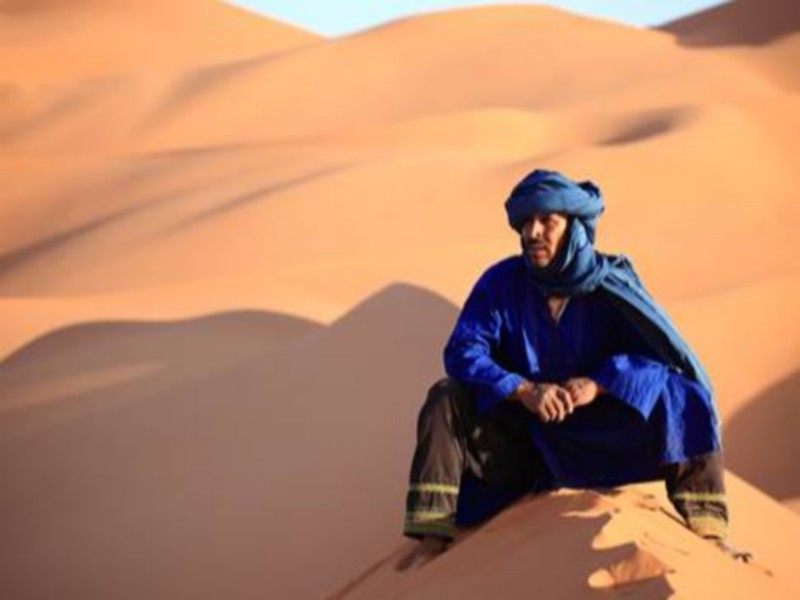
Les Touaregs
Les Touaregs Parmi les populations et civilisations réputées du désert est celle des “Touaregs”. Souvent stéréotypés “d’Hommes bleus” ou “de chevaliers du
Savoir plus...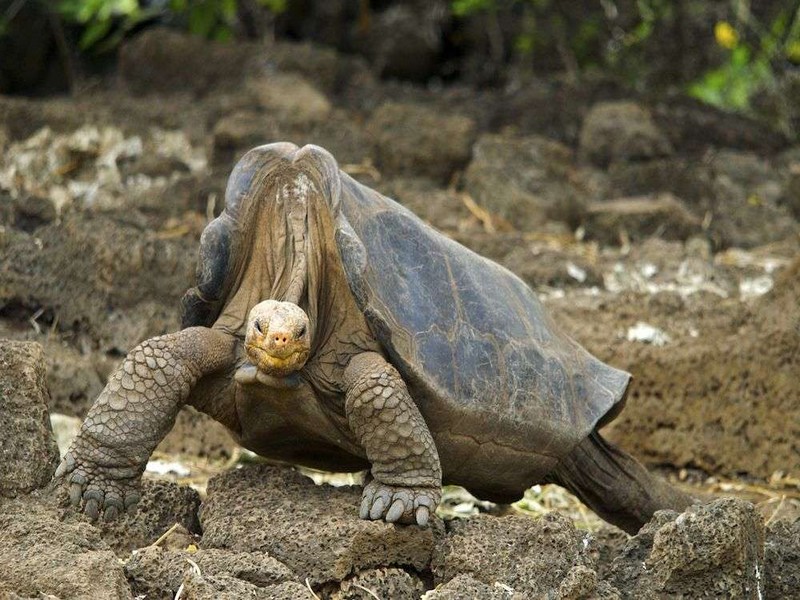
Les secrets de longévité de la tortue George dévoilés par son génome
Les secrets de longévité de la tortue George dévoilés par son génome Le génome de la tortue géante emblématique des Galápagos, George le solitaire, a été an
Savoir plus...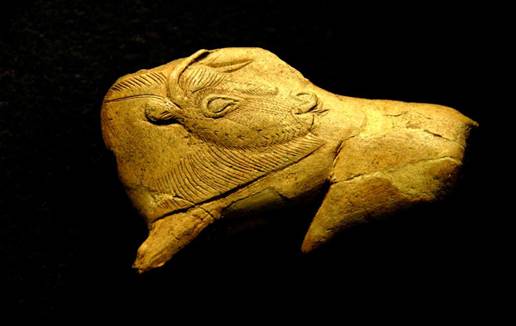
L'art préhistorique en 5 images exceptionnelles
Au cours du Paléolithique supérieur (période qui débute vers 30.000 av. J.-C.), les Hommes éprouvent le besoin de représenter leur quotidien et d'exprimer leurs émotions. Prése
Savoir plus...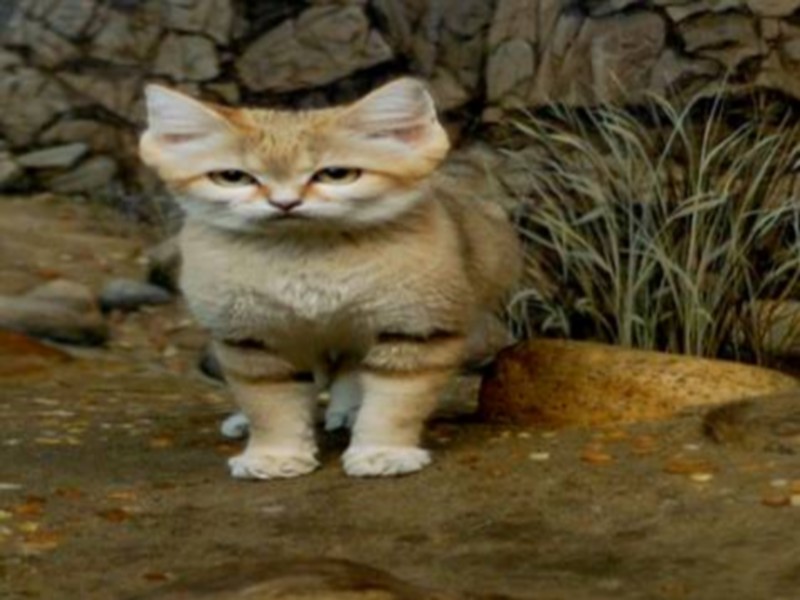
Le chat des sables
”Felis margarita”, le chat du désert Totalement adapté à la vie dans le désert du Sahara marocain, ce mammifère, dont l’existence est jugée en danger par l’UICN, reste
Savoir plus...Les tags en relation
En savoir plus sur " Géologie et TSGJB - AMDGJB ! "
Consulter les vidéos de " Géologie et TSGJB - AMDGJB ! " Consulter les photos de " Géologie et TSGJB - AMDGJB ! " Consulter les publications de " Géologie et TSGJB - AMDGJB ! " Consulter les éditions de " Géologie et TSGJB - AMDGJB ! " Consulter les communications de " Géologie et TSGJB - AMDGJB ! "Recherche du site
Recherche avancée / SpécifiqueVulgarisation à la géologie
Qu'est ce que les sciences de la terre: vulgarisation Qu'est ce que la géologie ? Géologie et TSGJB - AMDGJB !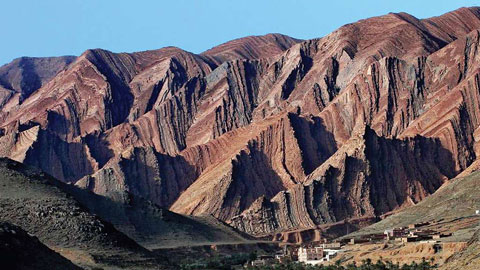
Géoparc et Recherche Scientifique
Le coins de l’étudiant
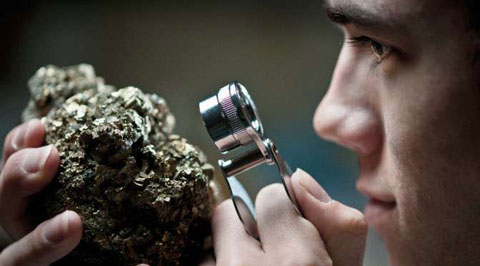

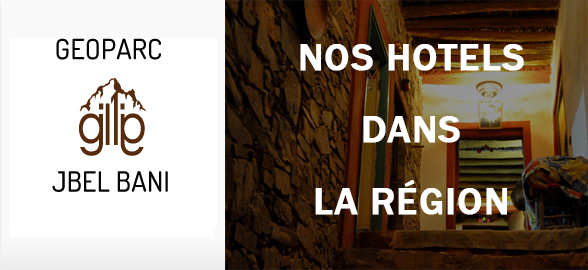
Blog Géoparc Jbel Bani
Dictionnaire scientifique
Plus de 123.000 mots scientifiques
Les publications
Géo parc Jbel Bani

Circuits & excursions touristiques

cartothéques


Photothéques
Publications & éditions



